 |
Compressed Air Trams
By John Prentice |
 |
Compressed Air Trams
By John Prentice |
After their first efforts with Mékarski locos, CGO decided to build some self-contained motor trams. Tests of these took place on 7/8/1894 between Vincennes and Boulevard de la Villette. A full service from Cours de Vincennes to Saint Augustine began on 17/9/1894. This route was designated TAD (All CGO bus and tram routes had letter designations, with trams starting with 'T').
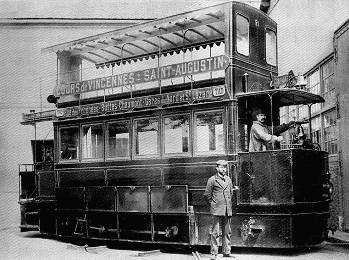 Tram 21, one of the 1894 series of CGO Mékarski cars. Note the panels open showing the mechanism.
Tram 21, one of the 1894 series of CGO Mékarski cars. Note the panels open showing the mechanism.
The trams were 4 wheel cars with a (standard) 1.90m wheelbase. They were single ended with a rear curved staircase giving access to a top deck which had a roof but open sides, the upper deck front being closed and flat. There was a warning bell fitted to the top of the driver's canopy.
They measured 8.10m long, 2.10m wide, 4.62m high with an unladen weight of about 11.5 tons which broken down was 5.5 tons for the chassis, 4 tons for the reservoir cylinders and 2 tons for the wooden body. Each car held 50 people - 20 inside on longitudinal seats, 6 on the platform and 24 upstairs on knifeboard seats. There were 31 cars built. The numbering of these cars is not certain but the writer thinks that originally they were numbered l-3l (based on photos). There were also a number of matching trailers.
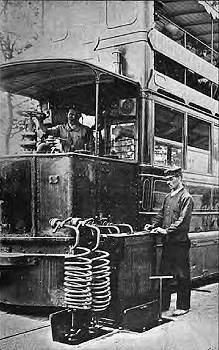 On-street charging point where the compressed air and steam were fed to the reservoirs on the tram.
On-street charging point where the compressed air and steam were fed to the reservoirs on the tram.
Suspended beneath the floor of the trams were 9 reservoir cylinders made of l3mm thick pressed steel of 60cm diameter and either 1.2m or 1.5m long according to position. Seven were used for normal running with two in reserve. This gave a total of 2,500 litres of air charged at 60 atmospheres (186 kilograms of air).
The bouillotte was made from sheet steel 20mm thick and held 275 litres of water at 165 degrees centigrade and 7 atmospheres. The familiar hand wheel regulator was on top. The water was heated at the charge point by a jet of steam. The two driving cylinders were outside the frame at the rear, driving the rear axle which used a connecting rod to drive that at the front. Walschaert's valve gear was fitted. The cylinders were 0.19m bore and 0.26m stroke. Wheels were 0.7m diameter. All the mechanism was enclosed by a sheet metal box with horizontally hinged door (4 each side). Cars were fitted with the Lipkowski air brake system which was fed directly from the normal air supply line.
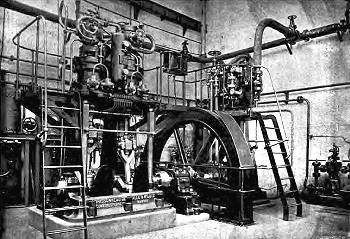 The compressor system used to supply the first CGO Mékarski compressed air tramway
The compressor system used to supply the first CGO Mékarski compressed air tramway
Driving was controlled firstly by the regulator which varied the pressure at the cylinders from 0 to 8 atmospheres. Secondly there was a three way tap which directed the supply either to the cylinders or to the brakes with a centre position for coasting. As full line pressure would be fed to the air brake, control was a little crude. Despite difficult gradients, the cars easily pulled double deck trailers weighing 9 tons unladen, and developed 35 hp using 15 kg of air per car kilometre.
The charging took place with air and steam at the terminus at Cours de Vincennes and at the stop on Boulevard de la Villette. The points were fed by mains respectively from Lagny depot, 18 Rue de Pyrénées and from the Puebla works, 194 Boulevard de la Villette. Later an extra point was installed at Saint-Augustine at Rue de la Pépinière fed by a main from Billancourt
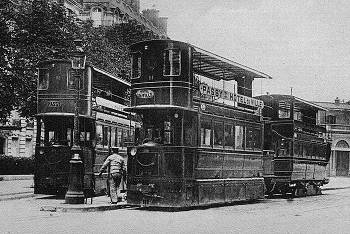 Cars 65 and 64 (with the trailer) of the 1900 series of CGO Mékarski cars at Gare de Passy. This was the charging point for air, water and coke for journeys on route TJ, Passy-Hotel de Ville.
Cars 65 and 64 (with the trailer) of the 1900 series of CGO Mékarski cars at Gare de Passy. This was the charging point for air, water and coke for journeys on route TJ, Passy-Hotel de Ville.
The second, and most common series of CGO Mékarski cars was introduced from 1900. In many ways they were similar to the 1894 cars and indeed also similar to the Serpollet and Purrey double deck steam cars of this era, and even some of the electric and accumulator cars.
They came into service as follows:-
| TAE | 23/3/1900 | Auteuil to Madeline |
| TG | 24/3/1900 | Montrouge to Gare de l'Est |
| TJ | 27/4/1900 | Passy to Hotel de Ville |
| TO | 26/5/1900 | Auteuil to Boulogne |
| TA | 30/5/1900 | Saint-Cloud to Louvre |
| TN | 17/8/1900 | La Muette to Rue Taitbout (via Ave Kleber) |
| TAF | 21/3/1902 | Montrouge to Saint Augustine |
| TAG | 12/8/1903 | La Muette to Rue Taitbout (via Ave. Victor Hugo) |
These 1900 series trams replaced the Rowan steam cars on route TO and the Mékarski locos on route TA. In all the other cases they took over from horse trams. At termini where there was no turning circle single cars were originally reversed on a small turntable, sometimes assisted by a horse. For the most part tracks for the compressed air cars were laid in Marsillon 20.5 kg/m rail.
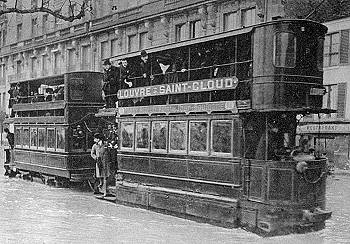 A Mékarski 1900 series compressed air tram and trailer during the Seine floods of January 1910.
A Mékarski 1900 series compressed air tram and trailer during the Seine floods of January 1910.
The routes of the horse cars had normally been identified by painting the trams in different colours. The mechanical trams however had more standard liveries. Trams kept to their own routes (thus the 1894 cars remained on route TAD) so boards were fixed on the upper deck sides, the whole length of the car with the route termini and painted in the route colour. Sometimes a second board below gave intermediate route details. In addition two colour lights at each end on the upper deck were shown after dark. For the Mékarski cars the colours were as follows:-
| Route | Car Livery | Destination Board Colour | Lights |
|---|---|---|---|
| TA | Green | Red | Green/Green |
| TG | Green | Red | Green/Orange |
| TJ | Brown | White | Orange/Orange |
| TO | Green | Red | Green/Green |
| TN | Green | White | Orange/Orange |
| TAD | Green | Black | White/Green |
| TAE | Green | Red | Green/Green |
| TAF | Green | Black | White/Orange |
| TAG | Green | Black | White/Orange |
| TAB (trailers) | Green | Black | White/White |
From 1911 to 1912 onwards the routes received numbers which were displayed at one end of the destination board, the letters remaining at the other end to avoid confusing the public. The routes were assigned numbers roughly in alphabetica1 order but some varied, e.g. TG became 8.
 The cross-roads of Avenue du Maine and Rue de la Gaite with (left) a Mékarski car on route TAF going to Saint Augustine. CGPT trolley/conduit electric car 214 of 1901 is on route 13 to Malakoff from Les Halles. It had originally been trolley/accumulator.
The cross-roads of Avenue du Maine and Rue de la Gaite with (left) a Mékarski car on route TAF going to Saint Augustine. CGPT trolley/conduit electric car 214 of 1901 is on route 13 to Malakoff from Les Halles. It had originally been trolley/accumulator.
Like their predecessors the 1900 series cars had a 4 wheel 1.90m wheelbase truck and were double deck with knifeboard seats upstairs, longitudinal seats down, and with a rear staircase. In the case of these new cars there was a 4 seat cross-bench seat at the front upstairs. Again they were single ended. The sides were open upstairs, but the cars could easily be distinguished from the 1894 series, as the upper deck front panel was curved. Mechanism was again enclosed this time with three horizontally hinged doors each side.
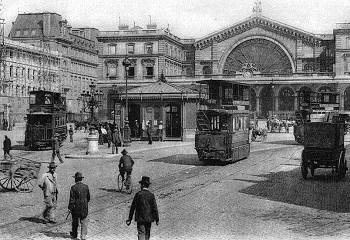 Two Mékarski cars at Gare de L'Est terminus of route TG from Montrouge. The car on the right is on the turntable. The tram on the extreme left is on CGO line TI (Cimetière St.Ouen to Bastille) and is a Serpollet steam car of 1897.
Two Mékarski cars at Gare de L'Est terminus of route TG from Montrouge. The car on the right is on the turntable. The tram on the extreme left is on CGO line TI (Cimetière St.Ouen to Bastille) and is a Serpollet steam car of 1897.
The cars were 8.32m long 2.0m wide and 4.8m high. They weighed 14 ton when loaded with water and air but no passengers. They carried 52 people (20 inside, 4 on platforms 28 upstairs). There were 148 cars. Records suggest that they were numbered 1-148, but since the author has found a photograph of 151, it was possible that the numbering commenced at 32, following after the 1894 series. The number was carried on the middle of the upper deck front panel.
The cars were very sparsely lit by 8 oil lamps, 4 inside, one each end upstairs to light the route indicators, one on the platform shining on the 'full' sign and one at the front.
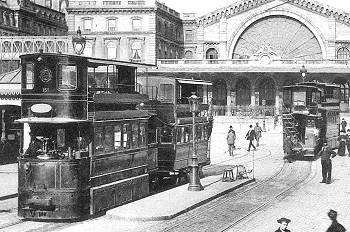 Two more Mékarski cars and trailers at the same location, Gare de L'Est terminus of route TG from Montrouge. The tram on the left is number 151 as mentioned above.
Two more Mékarski cars and trailers at the same location, Gare de L'Est terminus of route TG from Montrouge. The tram on the left is number 151 as mentioned above.
Air was stored at 80 atmospheres in 8 reservoir cylinders fitted longitudinally under the floor and made of 16mm pressed steel and having a total capacity of 2728 litres of air weighing 240 kg. The first 88 cars were supplied with a bouillotte as on former Mékarski cars where the water was re-heated by steam. From then on (in 1902) the bouillotte was fitted with a small internal firebox to a patent by Monsieur Bonnefond, which would continuously re-heat the water. It was fueled by coke, the smoke going out by a small direct chimney flue which passed through the upper deck. All cars were later (from 1904) fitted with this system. Water in the bouillotte, which held 150 litres, was replenished by a pump driven from one axle and fed from a 90 litre reservoir. Two safety valves were also fitted, set to 22 atmospheres.
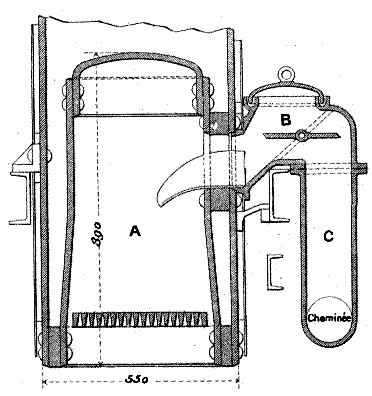 A drawing of 1903 shows the Bonnefond firebox as fitted into the bouillotte of later Mékarski cars. The fire was at A. The flap valve at B closed off the flue C, when coke was being added.
A drawing of 1903 shows the Bonnefond firebox as fitted into the bouillotte of later Mékarski cars. The fire was at A. The flap valve at B closed off the flue C, when coke was being added.
The regulator, placed between the air reservoirs and the bouillotte, was controlled by a wheel in the usual position. on top of the bouillotte. For normal running the cylinder pressure was 8-10 atmospheres. The low pressure of the air fed to the bouillotte was raised by about 2 atmospheres by the water vapour formed there at a temperature of 130 degrees centigrade.
The driving cylinders were at the rear, inside the frames directly coupled to the rear axle and with coupling rods to the front axles. A valve gear by Bonnefond was used as it proved more economic than the Walschaert's gear.
Braking was on the Soulerin system with direct and automatic application. The air came from its own control system and therefore was independent of the speed control avoiding the problems on earlier cars.
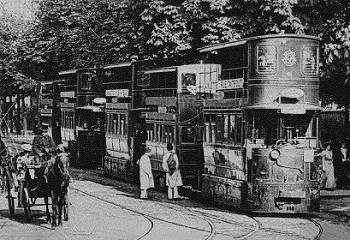 The La Muette terminus and air charging point of routes TN and TAG to Taitbout. Car 81 leads three trams and two trailers in this view circa 1905.
The La Muette terminus and air charging point of routes TN and TAG to Taitbout. Car 81 leads three trams and two trailers in this view circa 1905.
The cars developed 40-50 hp and could easily pull double-deck trailers, even up steep slopes. They consumed 11-15 kg of air per car kilometre according to route, also using 1 kg of coke and 4 litres of water. Range was around 16 km.
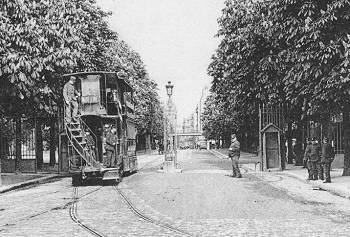 A car on route TAE at the terminus at Porte d'Auteuil with the charging point in the centre of the road.
A car on route TAE at the terminus at Porte d'Auteuil with the charging point in the centre of the road.
Air for the 1900 series cars at 80 atmospheres (1894 cars were 60 atmospheres) was generated in the works at Billancourt, 56 Quai du Point du Jour, Boulogne and fed by mains to the depots at Montrouge, Point du Jour, Auteuil (16 Rue Chanez), Mozart (58 Ave. Mozart) and the charge points in Faubourg Saint-Honoré (Carrefour Haussmann), Place Saint Augustine and Place d'Alma. The depot at Auteuil fed air on to a point at Porte d'Auteuil and the depot Mozart in turn fed the terminus at Passy-La Muette.
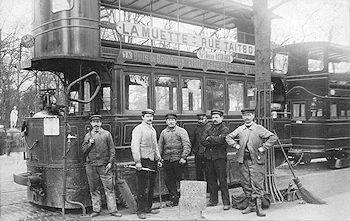 A car on route TN at the terminus at La Muette with the charging point and the servicing crew.
A car on route TN at the terminus at La Muette with the charging point and the servicing crew.
By 1902 the feed points for 1900 car routes were:-
| TA | Point du Jour: Air and Steam | Alma: Extra air |
| TJ | Passy: Air, water, coke | Alma: Extra air |
| TN | La Muette: Air, water, coke | Saint Honoré: Extra air |
| TAE | Auteuil: Air and steam | Saint Honoré: Extra air |
| TO | Auteuil: Air and steam | - |
| TG | Montrouge: Air and steam | - |
| TAF | Montrouge: Air and steam | Saint-Augustine: Extra air |
At a later date a point for extra air was installed at Gare de 1'Est for route TG, fed from the Puebla works.
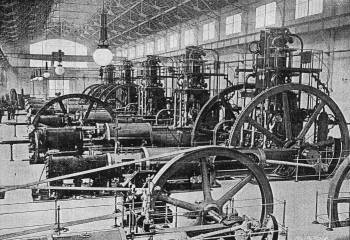 The compressor sets in the CGO works at Billancourt.
The compressor sets in the CGO works at Billancourt.
The works at Billancourt was in its day the largest installation for the production of compressed air in Europe. It used 3 stage compression at 4.3 atmospheres, 18 atmospheres and 80 atmospheres. There were 16 Babcock and Wilcox multi-tube boilers, supplied with purified Seine river water, feeding 7 compressor sets which in turn charged a battery of 500 litre tanks. It was said to use about 2 kg of coal per car/kilometre. Each compressor set had a horizontal triple-expansion steam engine driving the compressor. The low pressure cylinder of the compressor had water injected to cool the air. Between the second and third cylinders there was a tank containing serpentine copper tubes. These two cylinders and the tank were cooled by circulating cold water.
By 1909 the passengers carried per year for the Mékarski lines were (in millions) TG: 17.493, TAD: 8.056, TAE: 6.831, TA: 5.253, TN: 4.780, TAF: 4.081, the rest less than 4 million.
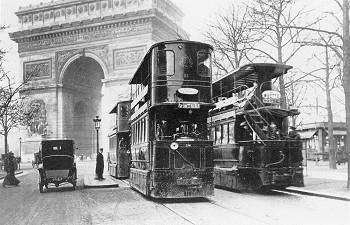 1900 series Mékarski car 95 and another similar car at Place de l'Etoile, with the Arc de Triomphe in the background. The trams are on route TAG, La Muette to Rue Taitbout.
1900 series Mékarski car 95 and another similar car at Place de l'Etoile, with the Arc de Triomphe in the background. The trams are on route TAG, La Muette to Rue Taitbout.
Like in Nantes, the Mékarski cars worked well, but by 1914 they were dated, and were replaced by electric trams. The last car was on the TAE Auteuil to Madeleine route on 2nd August 1914.
![]() Go now to Next Section
Go now to Next Section
![]() Return to Index
Return to Index